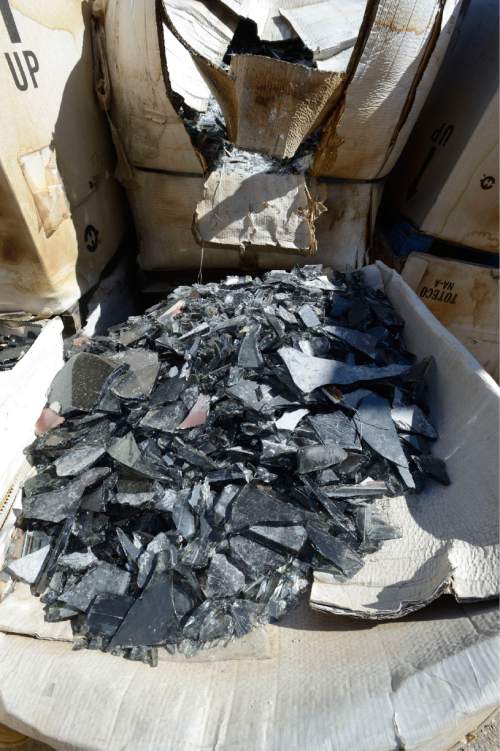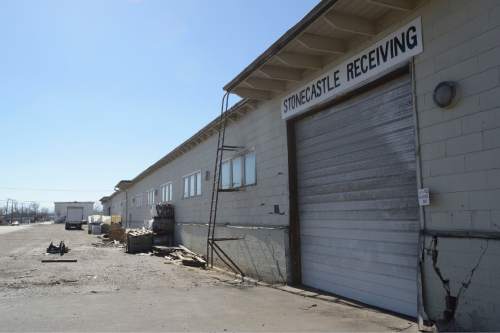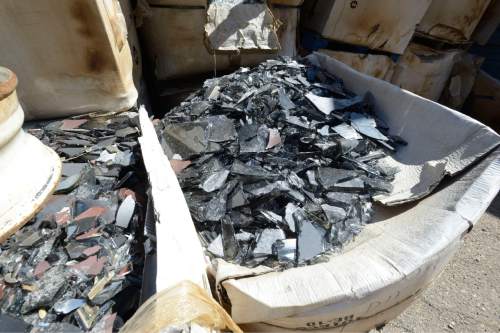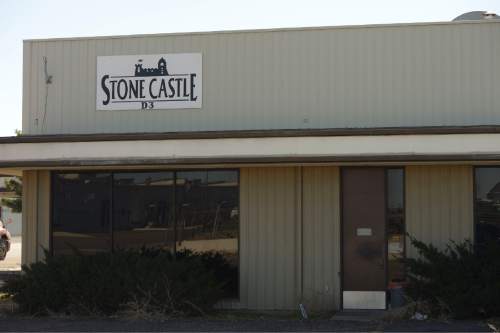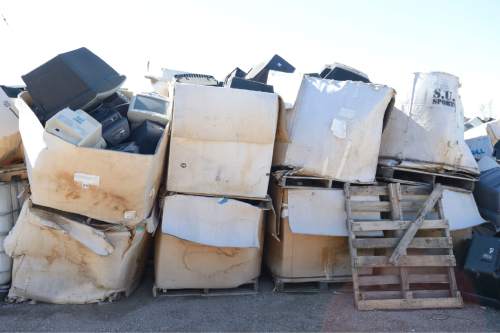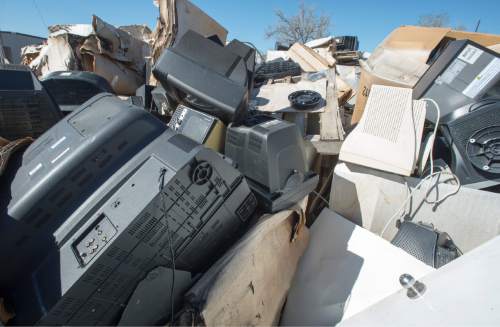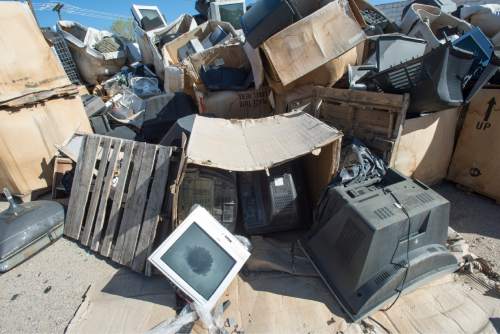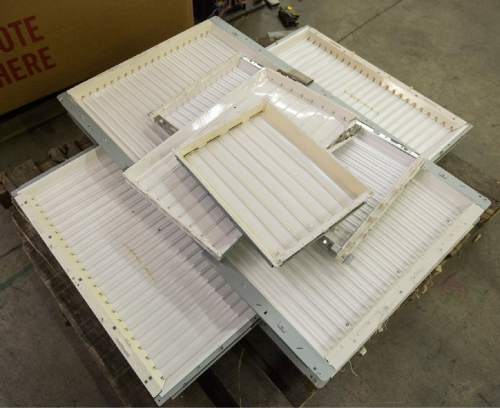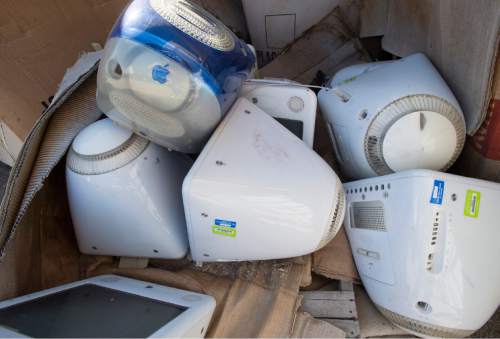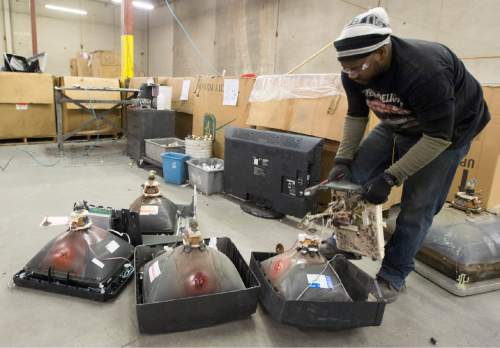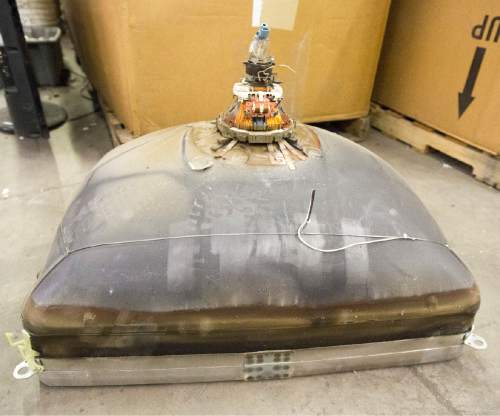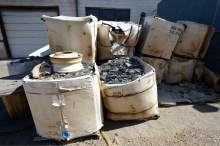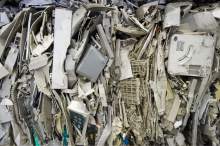This is an archived article that was published on sltrib.com in 2015, and information in the article may be outdated. It is provided only for personal research purposes and may not be reprinted.
Clearfield • In September 2013, Anthony Stoddard presented the owners of an underused lot an easy way to make $1,400 a month.
Within weeks, Robert Beaslin's property near the Freeport Center industrial park was covered with old televisions from Stoddard's Stone Castle Recycling, which operated out of a large warehouse down the street.
Stoddard's rent money flowed for only about seven months, but the headaches of doing business with him could last a lifetime.
"I spent four years paying for this property. I bought a property I can't use," Beaslin says, surveying the stacks of "Gaylord" boxes slowly falling apart, their electronic bounty drooping out.
Besides televisions, Stoddard's piles of e-waste include computer monitors, microwaves, DVD players and vacuum cleaners.
"You would be surprised how much of this stuff still works," says Beaslin, whose trucking business was damaged after Stoddard's TVs caught fire last November.
The Beaslin lot is one of six rented locations across the state that Stoddard has filled with old televisions or broken cathode-ray tubes, then abandoned as state, local and federal regulators came after him for various unethical practices, including failing to pay vendors and employees.
Stockpiled TVs caught fire last year at two other Stone Castle sites — an outdoor dump in Parowan and a warehouse in Cedar City.
Stoddard's dumps pose hazards to the environment and public safety, liabilities on property owners and big tabs for taxpayers. And 46-year-old Stoddard, a Syracuse resident, faces numerous lawsuits and misdemeanor charges in courts across Utah stemming from his failed recycling business.
But so far, he has not paid for any of his defunct recycling centers or their cleanup.
He also is awaiting trial on felony charges in Cedar City for allegedly passing bad checks and submitting affidavits that falsely identified him as the owner of vehicles he sold to a scrap yard.
"This guy is a total crook and hasn't learned from this lesson," says Andy Renfro, whose Clearfield warehouse now is filled with 3.5 million pounds of Stone Castle's leaded television glass. It will cost him $500,000 to dispose of it.
—
Small screen, big problem • For several years, Stoddard collected televisions from Deseret Industries and school districts without charging anyone. He illegally stockpiled them and other electronics equipped with now-obsolete cathode-ray tubes, or CRTs.
Mountains of the clunky monitors are entering the national waste stream in the wake of the electronics industry's transition to flat screens, while the market for the old monitors' leaded glass has vanished.
Because CRTs contain toxic substances, improperly handled units are considered hazardous waste that cannot be casually landfilled. Recyclers can recover a dollar or two's worth of copper from the funnel yoke and a little value from a TV's circuit board and plastic housing.
"Dealing with the rest of it costs you money. Doing it responsibly is a net-negative value," says Jim Puckett, executive director of the Basel Action Network, or BAN. "Smart recyclers were telling consumers, 'You have to pay me money to take that.' The responsible ones are using that fee to do it right."
Processing CRTs is heavily regulated and Stoddard broke many of the rules, according to 2013 inspection reports compiled by the Utah Department of Environmental Quality.
The Stone Castle mess reflects a global problem arising from the rapid turnover in electronic technology. Puckett's group is dedicated to the responsible handling of e-waste and has established a certification system for identifying the processors who have adopted best practices.
Nearly a billion CRT televisions and computer monitors were sold in the United States between 1980 and 2010.
Since then, waste processors have stockpiled CRT glass as the market for the material vanished. And the piles will only get bigger, with another 6.2 million tons of CRT-equipped devices expected to be discarded by 2022.
The glass tube comprises about two-thirds of the television's weight. Each holds about 4 pounds of lead on average. Most of the lead is contained in the funnel tube, put there to protect the consumer from gamma radiation. Since the screen panel needs to be transparent, barium is used instead of lead.
"It's more expensive and less toxic," Puckett says.
But the inside surface of the panel glass is coated with a powdery substance called phosphor, a luminescent material that contains cadmium. The heavy metal is as toxic as lead and should be wiped off before the glass is processed.
Under BAN's best practices outlined in its e-Steward program, the panel should be separated cleanly from the funnel glass using high-precision saws or lasers.
"Once you cut into glass, you have glass particles in the air presenting another hazard to workers," Puckett says. "If you don't clean off the phosphor, it's still a dangerous situation for anyone manipulating the glass."
Low-end processors such as Stoddard's Stone Castle cannot afford the equipment to safely process the tubes.
Salt Lake City-based Metech Recycling, which BAN certified as an e-Steward, ships intact CRTs to a Southern California processor, who uses lasers to separate the panel glass. Any broken units are packaged in plastic for shipment, according to sales manager Scott Kay. The processor melts the leaded glass into ingots, which are sold to a manufacturer in India believed to be the world's last producer of CRTs.
BAN has documented cases in which businesses claiming to be green recyclers take CRTs for free to get other, more valuable waste or collect a recycling fee, then fail to invest in safe management.
"Utah is the most horrific story we have seen because of the fires," Puckett says. "When you have a fire burning the plastic housing, you are producing dioxins, and that's a whole new category of toxin."
—
Shattered glass, shattered dream • Environmentalists allege that state waste managers allowed Stone Castle to stay in business — despite knowing the problems with the operation.
Puckett contends the Utah Department of Environmental Quality permitted Stoddard to keep collecting televisions long before it finally cited the company's violations at its Clearfield and Parowan operations in late 2013.
By then, Stoddard was shifting the burden of his worthless stockpiles onto hapless landlords such as Renfro.
Stone Castle started renting 40,000 square feet of space in Renfro's warehouse west of the Freeport Center in 2008 for $5,000 a month.
"I was attracted to renting to him because he said it was a zero-waste facility. I like doing green things," Renfro says. "He said they sweep the floors and recycle that as well."
It turned out little recycling was taking place.
Stone Castle employees were smashing CRTs with hammers and storing the shards in hopes that a market would develop for the glass.
Such stockpiling is known as "speculative accumulation" — something Utah regulators should never have tolerated, Puckett says.
Stoddard was always behind on rent and Renfro evicted him in June 2014. He won a $121,000 judgment for unpaid rent, but he holds out little hope of collecting.
Meanwhile, he must find some legal way of disposing of the glass before the property can be used or rented again.
None of a handful of phone contacts associated with Stoddard and Stone Castle is a working number. Reached by cellphone, former sales manager Brandon McKay declined to discuss Stone Castle.
—
Feds step in • DEQ's Division of Solid and Hazardous Waste started monitoring Renfro's warehouse in April 2013, documenting numerous violations:
Old televisions were stored outside, haphazardly packed into open, damaged Gaylord boxes. Boxes of crushed glass were not properly labeled. Stone Castle had no approved operations plan.
Inspectors tracked 304,000 pounds of glass Stoddard had shipped to Clean Harbors' Grassy Mountain landfill in Tooele County. Tests indicated the waste contained hazardous levels of lead, but Stoddard had mischaracterized it on the manifests as nonregulated waste.
Solid-waste division inspectors then heard of a field west of Parowan, where Stone Castle had illegally dumped televisions. In December 2013, the state ordered Stoddard to clear the field filled with 1,800 cubic yards of electronic waste, weighing 765 tons.
Stoddard failed to act and the following March, the place burned.
The charred ruins were accessible to anyone and leaching toxins into the ground, prompting federal intervention.
This winter, the Environmental Protection Agency stepped in, grinding up the material, mixing it with phosphorus fertilizer and encasing all of it in concrete. The blocks then were landfilled at a site in the town of East Carbon, according to EPA on-site coordinator Steve Merritt.
Total cost for the cleanup was $350,000. EPA has initiated a criminal probe, he says.
—
Burning questions • Still, Stoddard continued to collect.
A few months after state inspectors confronted the business owner about improperly stored televisions outside Renfro's warehouse, Stoddard approached Robert Beaslin's father, Mark, in September 2013, asking if Stone Castle could store TVs on the family's lot.
By then, landlords in St. George and Salt Lake City had court judgments against Stone Castle totaling $65,000 for unpaid rent at stockpiles Stoddard had abandoned.
But the would-be recycler struck a deal with Beaslin. Within weeks, Stone Castle transferred most of the Gaylord boxes illegally stacked at Renfro's warehouse to Beaslin's fenced lot, a block down the street.
"Tony said he was processing them," Beaslin says. "It was never supposed to be permanent. They were supposed to be in plastic totes to protect them from the elements."
One day last November, he noticed smoke pouring from a pile in one corner. The ensuing fire consumed his trailer and half his quonset hut before firefighters contained the blaze.
Investigators have not been able to determine the causes of the Clearfield fire or the other two at Stone Castle's Iron County sites.
Puckett figures that the lenses in projection TVs could have acted like magnifying glasses, focusing the sun's rays onto combustible material.
Whatever the cause of the destruction, many of Stoddard's landlords are trying to clean up the defunct recycler's mess.
Beaslin's not sure how to salvage his property.
"They've told me it's my responsibility," Beaslin says. "I want to make sure it's going to a place that's responsible, and that's 10 times harder than taking it to a landfill."


